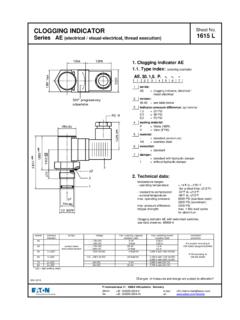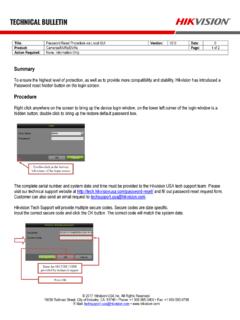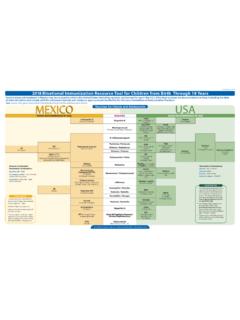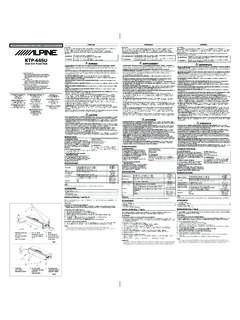Transcription of PECS to SGD: Guidelines and Recommendaations for a ...
1 PECS to SGD: Guideline es and Reco ommendaations for aa Successfu ul Transitio on Position SStatement: Pyramid Educational Consultantss' position reegarding prooviding speeech generatiing devices (SGD) including touch scree en tablets with w apps is that best aand evidencee based pracctice for tea aching functiona al communica ation and soccial interactio on for individduals with ASSD who are n not speakingg is to begin inte ervention wiith PECS, and d to transfer to an SGD oonly after spo ontaneous, fu unctional, piccture . based commmunication n skills have b been established and the learner has m mastered Phase IV of thee PECS protocol. This sequen nce assures that t the learnner has acquuired indepenndent social approach, piicture discrimina ation, commu unicative perrsistence, and d the buildingg of multi piccture sentences. Introducttion The Picture Exchange Communicattion System (PECS ) is a n evidence b based augmen ntative/altern native communication system m that is oftenn chosen as aa communicattion interventtion for learn ners with autism or other commplex commu unication needs who are n not developin g spoken com Speech langguage pathologists and othe er clinical/edu ucational service providerrs often plan n to transitio on from PECSS to a speech geenerating devvice (SGD) forr long term u use after learnners successffully progresss through thee PECS protocol, particularly ffor those learrners who do not develop speech follow wing extendeed use of PEC CS and complementary interrvention efforts.
2 In the t current document, we present and desscribe recommendations for best practice es associated with this tra nsition, from assessment of the learneer and the device prior to the transition from PECS th hrough to inttervention pllanning and aassessment oof the learner's ssuccessful ind dependent usse of the SGD D. When con nsidering ado opting or transitioning a communicatiion system, iit is importan nt to consideer the definition of communication. Communication involves behaavior directed d to another person who o then mediates access to a rreinforcer, wh hich may be ttangible ( ,, an object orr activity) or ssocial ( , shared attention). Of particular relevance e to individuaals with autis m or other ccomplex communication n needs, communications need d to be initiaated spontan neously and completed independently in order tto be effective in real world d contexts.
3 While W teachin ng these skillls using high tech devicess may be posssible, extensive experimentaal research haas already produced solid evidence thaat PECS training results in n swift increases in spontaneo ous and functtional picture e based comm munication in most childreen with autism m and related developmentaal disabilities. Experimen ntal researchh also furtheer suggests tthat PECS traaining produces notable posiitive effects o on speech an nd social deveelopment in some childreen with autism m. In particularr, recent research suggestss that PECS iss equally as eeffective for ffacilitating sp peech comparred to more direectly speech based appro oaches in you ung children with autism who displayy very few sp poken words. Thherefore, our position is th hat best and e evidence baseed practice fo or children wiith autism wh ho are o transfer to an SGD onlyy after sponttaneous functional not speakking is to inittiate PECS traaining, and to picture baased commun nication skillss have been e established vvia the PECS p protocol.
4 Thee Guidelines b below 1 Copyright, 2. 2014, Pyramid Edducational Consultants May be e reproduced. PECS and tthe Picture Exch hange Communiication System are registered ttrademarks of P. Pyramid Educatiional Consultantts, Inc. ( ) All rights reserved. are design ned to suppo ort effective transition from m PECS to SG. GD in learnerss with autism m or other com mplex communication needs. Pyramid EEducational CConsultants do oes not endorse or recom mend any sp pecific speech generating d device or app for tablets. Raather, our reccommendatio on is to assesss the individual's current PECS skills aand to choose ann SGD or tablet app that w will best acco ommodate thhe individual''s current com mmunication n skills and allow w for continueed language growth. Best Pra actice Reco ommendaations and Guidelines Assessin ng the Lea arner Beforre the Tran nsition As a geneeral guideline e, we recomm mend that ind dividuals not be transition ned from PEC CS to an SGD D until they have e mastered Phases P I through IV of the standard PPECS training protocol.
5 Co ompletion of PECS Phase IV ensures maastery of the e following PECS based P sskills, which we considerr pre requisittes to transitioning to an SG. GD. Specificaally, we recoommend thatt the learnerr has an estaablished histo ory of spontaneous and inde ependent use e of the follow with his or her PECS book prior to the team wing skills w considerinng a transition to an SGD. Persistence in n identifying aand approach hing communnication partn ners across en nvironments Discriminatio on between 20. 0 pictures in a picture arraay Navigating fro om page to p page while building a Senteence Strip Pointing with h index finger to individual pictures duriing Sentence Strip exchange Recomme endation 1: PPECS Commun nication/Langguage Samplee. Collect a co ommunication n/language saample via observvations conduucted across sseveral days tthat includess (a) total num mber of pictures currently used, (b) averagge number of pictures use ed per sentence, (c) longeest picture seentence used d, (d) frequenncy of PECS or other no tecch communiccations produced across the day, (ee) rate of sp pontaneous vversus prompted d uses of PECSS communicaations, and (f)) average tim me or number of steps neeeded to comp plete a PECS baseed communiccation exchange.
6 Consider all of the pictures in tthe learner'ss PECS book, even those that are used onnly occasionally. Rationalee: In any com mmunication ttransition, the responsiblee team has aan ethical ressponsibility to o plan the transition in a maanner that en nsures that th he individual does not lose any current communiccation es. This goal is particularlyy true for ind capabilitie dividuals who have only a limited reperrtoire of functional and sponntaneous com mmunication skills. The collection a nd consideraation of this language saample ensures thhat the team has a full and d representattive sample oof the learnerr's current reaal world functional communication skills. Specific colle ection and co onsideration oof data on the relative rattes of spontan neous versus proompted PECSS based comm munications iss particularly important, because sponttaneous initiaation 2 Copyright, 2.
7 2014, Pyramid Edducational Consultants May be e reproduced. PECS and tthe Picture Exch hange Communiication System are registered ttrademarks of P. Pyramid Educatiional Consultantts, Inc. ( ) All rights reserved. of communications is a key area of weaknesss for learner s with autism m and relateed communiccation er back to the results of tthis assessmeent, or re conduct it, oncce the disorders. The team can also refe learner haas transitione ed to the SGD D. Recomme endation 2: Picture P Discrimination Skills. Assessmeent of picturee discrimination skills, sho owing clear mastery of at least 20 symbolss on each of aat least three pages within n the PECS bo ook. Rationale f the use oof an SGD aas a functional communiccation e: Picture disscrimination is required for system. Research has found thatt insufficient picture discrrimination skkills can lead d to abandon nment and/or misuse of the SSGD by the leaarner ( , ussing SGD as aa toy; Calculattor & Johnson n, 2008).
8 Recomme endation 3: P Persistence in n Social Comm Approach. Asssessment and planning reelated municative A. to the leaarner's capaccity to transffer the skill of o independeently finding a Communiccative Partneer and bringing the SGD to that individual, across a variety of f environmen nts, contextss, and individ duals. Alternativvely, it may be appropriate e for some le earners or de vices for the learner to fin nd Communiccative Partners aand bring the Communicattive Partners to the SGD. Rationalee: Communiccation is funcctional when it is spontanneously and independently implemented by the comm municator too effectively provide a message m to mmediate the behavior of a Communiccative Partner. Identifying an nd exchangin ng with a Com mmunicative Partner is a ccritical first sttep initiation to all communication skills that is typicaally severely limited in inndividuals wiith autism.
9 Therefore, caareful planning and considerration is requ uired for thiss aspect of coommunicatio on in the tran nsition to an SGD. This includes ensuring that the learner is initiatin ng social com mmunicationss independenttly across a variety of environments, contexts, and in ndividuals, reeflecting solidd persistencee in initiatingg and successsfully completin ng communiccation. Addittionally, the team t should develop lesssons to addreess learner rrepair strategiess' for when th he SGD's voice e is not heard d ( , in noissy environmeents). Recomme endation 4: M Mastery of Naavigation for Sentence Strrip. Assessmeent and plann ning related tto the learner's capacity to trransfer the m multiple step p procedural skkill of indepen ndently naviggating a PECSS book to create a picture bassed sentence on a Sentencce Strip, and to use an ind dex finger to point to/toucch the individuall pictures on tthat Sentence e Strip withou ut promptingg.
10 Rationalee: Successful use of an SGD requires mastery of a m multiple step n navigational p process in ord der to create a picture basedd sentence. In order to complete thhis task, the learner musst be proficieent in touching individual picctures, alongsside other navvigational skillls. Thereforee, it is importtant for the leearner to have mastered m the e creation of picture base ed sentences via PECS, ass well as poin nting to indivvidual pictures o on the Sentennce Strip, bothh of which are e PECS Phasee IV skills. PECS Fea Match P atures to SG. GD Featurres to Choo ose Approp priate Devvice In any com mmunication transition, th he responsible team has a n ethical resp ponsibility to plan the tran nsition in a mannner that ensurres that the in ndividual doe es not lose an y current com mmunication capabilities. This 3 Copyright, 2. 2014, Pyramid Edducational Consultants May be e reproduced.





